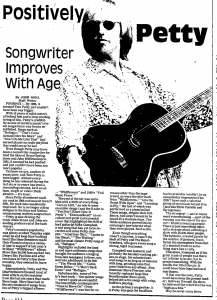Positively Petty: Songwriter Improves With Age
By Josh Noel
Casa Grande Dispatch - Thursday, April 27, 1995
PHOENIX -- By 1985, it seemed Tom Petty just couldn't have been any bigger.
With 10 years of solid material behind him and a long-winding string of hits, Petty's credibility as one of modern music's finest songwriters was firmly established. Songs such as "Refugee," "Don't Come Around Here No More" and "Don't Do Me Like That" had earned places on radio playlists that would never be lost.
Even though Petty may have been a second-tier behind the likes of Bruce Springsteen and John Mellencamp in 1985, it seemed he had peaked and just couldn't have been any more popular...
Yet here we are, another 10 years later, and Tom Petty is even bigger. Almost everything he has released during the last six or so years has been a resounding success, be it an album, single or video (think about it -- it's true).
Since Petty abandoned stadium rock in 1986 and moved toward folk, his work has consistently improved. He is no longer riding shotgun to the Boss and Mellencamp among modern songwriters -- Petty is now driving the truck while Bruce and John are loading produce out of the back (sorry).
Petty's massive popularity was plenty evident Tuesday night when he and long-time backing band The Heartbreakers made their Phoenix stop on a nation-wide tour in support of last year's brilliant "Wildflowers" album. More than 20,000 fans packed into Desert Sky Pavilion and after two hours of Petty's fine showmanship, they seemed to leave happy.
Appropriately, Petty and The Heartbreakers focused most of their efforts on the material from the last six years that made them huge. More than half of the set consisted of songs from two of Petty's biggest albums -- "Wildflowers" and 1989's "Full Moon Fever."
The rest of the set was sprinkled with a little of everything -- "Girl on LSD," an ode to women and/or drugs (and the B-side to "You Don't Know How It Feels"), "Diamondhead" an excellent surf-punk instrumental that highlighted the skill of lead guitarist Mike Campbell, a new song that has yet to be recorded and song Petty classics: "American Girl," "Listen to Her Heart," "The Waiting" and the most classic Petty song of all, "Refugee."
Highlights included the louder and more anthemic songs that brought the audience (ranging from late teenagers to those, um, well into adulthood) to its feet -- "You Wreck Me," "Cabin Down Below," "I Won't Back Down" and "Refugee."
Unfortunately, some of Petty's best work -- the quieter songs -- weren't quite as successful. The beautifully contemplative "Time to Move On" (from "Wildflowers") was lost for no reason other than the huge crowd, as were the title track from "Wildflowers," "Into the Great Wide Open" and "Learning to Fly," the last of which was performed as a piano ballad. Those songs, despite their brilliance, just aren't meant to be heard at a stadium show. The fickle audience proved this by seeming to lose interest when they were played. Such is life.
Even though everything wasn't a success, it wasn't the fault of Petty and The Heartbreakers, who gave every song a strong, tight treatment.
Campbell was fantastic and probably the hardest-working person on stage. He extended several songs to as long as 10 minutes with long, grinding solos that aren't heard on any album. Also, drummer Steve Ferrone, who recently replaced long-time Heartbreaker Stan Lynch, helped drive the songs with crisp, faultless playing.
As the primary songwriter, it is Petty who gets the headlines but he probably wouldn't be as consistently impressive if he didn't have such a talented group of musicians behind him (just like Elvis Costello and Springsteen).
The strangest -- and at times most overwhelming -- part of the evening was the size of the concert: 20,000 streaming people. There is just something inherently strange about attending a show with 20,000 other people. The hysteria, created purely by the number of persons, transform the atmosphere from that of a musical event to something more like a rally.
Therefore, it seemed as if the great mass of people was there not to listen to music, but to protest something. With the smells that filled the area, it could have been the legalization of marijuana.
If that was the case, Petty could have been the protest leader; mid-way through the show, he informed the crowd that he was "high as a kite."
May he never come down.

